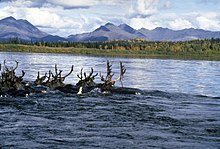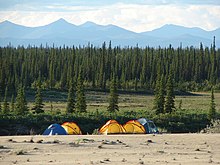
Kobuk Valley National Park is a remote, little-visited national park in Arctic Alaska, known for its wilderness, sand dunes, and caribou migrations.
Understand
editVisitor information
editThe park headquarters are at the Northwest Arctic Heritage Center in Kotzebue.
History
editIt was declared a national monument by President Jimmy Carter on December 1, 1978, then made a National Park in 1980.
Landscape
editThe park consists of the valley of the Kobuk River and includes three sets of sand dune fields.
Flora and fauna
edit
The park lies in a transition zone between boreal forest and tundra. See thousands of caribou that migrate annually between their winter breeding grounds, south of the Waring Mountains, and their summer calving grounds, north of the Baird Mountains. Other mammals include moose, wolves, and foxes. Migrating birds come here in the summer.
The park's sole amphibian is the wood frog, a cold-blooded creature which survives the icy winters by freezing solid and waking up again in the spring.
The Kobuk locoweed (Oxytropis kobukensis) is a small flowering plant endemic to the park. Ask at the Northwest Arctic Heritage Center in Kotzebue for advice on how to spot it.
Climate
editSubarctic climate. Average low temperatures in January are −8 °F (−22 °C), and can reach nighttime lows of −50 °F (−46 °C). Summer temperatures average around 65 °F (18 °C), and can reach 85 °F (29 °C). Since the park is above the Arctic Circle, the sun does not set from June 3 to July 9, and the sun is visible for only 1-1/2 hour on the winter solstice, with long periods of twilight on either side of sunrise and sunset. As is the case over all of northern Alaska, the aurora borealis is often visible on winter nights when solar activity is high. Snow can happen at any time of the year. Wind and rain are common in summer.
Get in
editThere are no roads leading into the park, so most visitors enter by air taxi from Bettles (which has flights from Fairbanks) or Kotzebue (which has flights from Anchorage). Flights are available year-round but are not cheap and depend on weather. In the summer it's possible to enter by boat, and in the winter by snowmobile, ski, snowshoe, or dog sled.
By plane
editBy foot
editHiking from Bettles or Kotzebue is possible, but only for serious wilderness trekkers.
Fees and permits
editThe park is open year-round and has no entry fee. Permits are not required for independent travelers but are required for organized groups.
Get around
editSee
edit
- Great Kobuk Sand Dunes
- Caribou
- 1 Kobuk River.
- 2 Onion Portage (Paatitaaq). A bend in the Kobuk River where hunters have been hunting caribou for generations. Archeologists have found evidence of human activity here for at least 8,000 years.
Do
editOutdoor adventures: hiking, wildlife watching, photography, etc.
Buy
editEat
editDrink
editSleep
editStay safe
editKobuk Valley National Park is vast, remote, and undeveloped. It may be hard to get help in an emergency, so you must be self-sufficient and take responsibility for your own survival. Cell phones may not work, so consider carrying a satellite phone and a PLB (Personal Locator Beacon).
Challenges like traveling the park by snowmobile or ski should only be attempted if you have experience in Arctic winter survival. See also Cold weather.
The park has bears and moose. Keep your distance from them.


